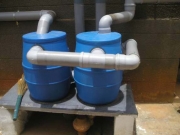Rainfall and other forms of Precipitation
Water resources in Jhansi and Tikamgarh districts (Madhya Pradesh) - A status report (2007)
Posted on 03 Oct, 2009 05:56 PMThis status report prepared by Development Alternatives contains brief background information about the Bundelkhand region, details about the physical profle (topography, drainage and river systems, land usage, climate, rainfall), water resources information (water demand, availability, supply and accessibility) and information on sanitation practices (toilets, personal hygiene, solid waste management, liquid waste disposal, availability of water for sanitation).
Background on the Meteorological Datasets
Posted on 18 Sep, 2009 11:27 AMWe foresee that this data can be useful in making rainwater harvesting and water balance estimates, in various research areas, climate change adaptation studies and more. We also believe in the democratising effect of having this kind of data freely available to the general public.
How to create check dams for water conservation
Posted on 15 Sep, 2009 01:07 PMIn addition to controlling gully erosion, check dams also serve to slow the movement of water, allowing increased percolation into the soil. Just above a check dam is a good place to put in a percolation structure. Silt that builds up behind the dam creates good farmland, which can be planted after the rains while it retains moisture. The following series of pictures show one farmer’s success with building a percolation tank just upstream of a series of check-dams.
Water filters used in a rainwater harvesting system - A presentation by Arghyam
Posted on 04 Sep, 2009 10:38 AM This presentation by Arghyam deals with filters used in a rainwater harvesting system as also in other sources to remove suspended pollutants from rainwater collected. In a rainwater harvesting system, the water comes in contact with several surfaces, such as the roof or gutters. Water sources too are contaminated by various minerals and chemicals. These affect the colour, odour, taste and composition of water.Its flow becomes possibly mixed with leaves or dust.
This presentation by Arghyam deals with filters used in a rainwater harvesting system as also in other sources to remove suspended pollutants from rainwater collected. In a rainwater harvesting system, the water comes in contact with several surfaces, such as the roof or gutters. Water sources too are contaminated by various minerals and chemicals. These affect the colour, odour, taste and composition of water.Its flow becomes possibly mixed with leaves or dust.
India's experience with drought management: Changed perspectives and challenges
Posted on 29 Aug, 2009 02:43 PMThis document describes the drought situation in India over the years, the earlier perspective at drought management and the gradual change in perspective at managing droughts that evolved over the years.
The how, what, when of climate change: Background and basics
Posted on 29 Aug, 2009 02:09 PMClimate Change is a significant change in temperature, wind patterns and precipitation that occurs over a long period of time. Some of these changes occur in cycles over decades, hundreds, thousands and millions of years; some could be random occurrences.
Using water sustainably in agriculture: Increasing productivity and farm income
Posted on 29 Aug, 2009 01:29 PMAgriculture is a vital sector in India with about 60% of the population engaged in agricultural vocations and contributing to about 30% of the GDP. It consumes about 80% of water used in the country and 76% of the net irrigated area in the country is from ground water sources.
The many large scale impacts of climate change
Posted on 26 Aug, 2009 01:50 PMThe heat evaporates the moisture in the soil rapidly leading to widespread drought conditions. The changes in ocean temperatures are modifying the ocean currents, thus creating erratic and extreme weather conditions - creating more intense and frequent storms and cyclones; thus creating cycles of floods and drought.
From erratic rainfall to vector borne diseases: The many effects of changing climate on environment and lifestyle across the globe
Posted on 26 Aug, 2009 12:16 PMGlobal warming induces an increase in global precipitation through the augmentation of evaporation. According to the IPCC, rainfall patterns are likely to be modified with some regions becoming more arid and others experiencing more rainfall.
How changing climate and melting glaciers affects nations across the globe: Spotlight on the Himalayas
Posted on 25 Aug, 2009 05:11 PMAs observed by the United Nations Environment Program (GRID-Arendal) ice and snow are major components of the climate system. That is why human induced climate change can be first observed in Polar Regions where most of Earth's snow and ice are concentrated. In these areas global warming induces the progressive melting of ice and snow.





